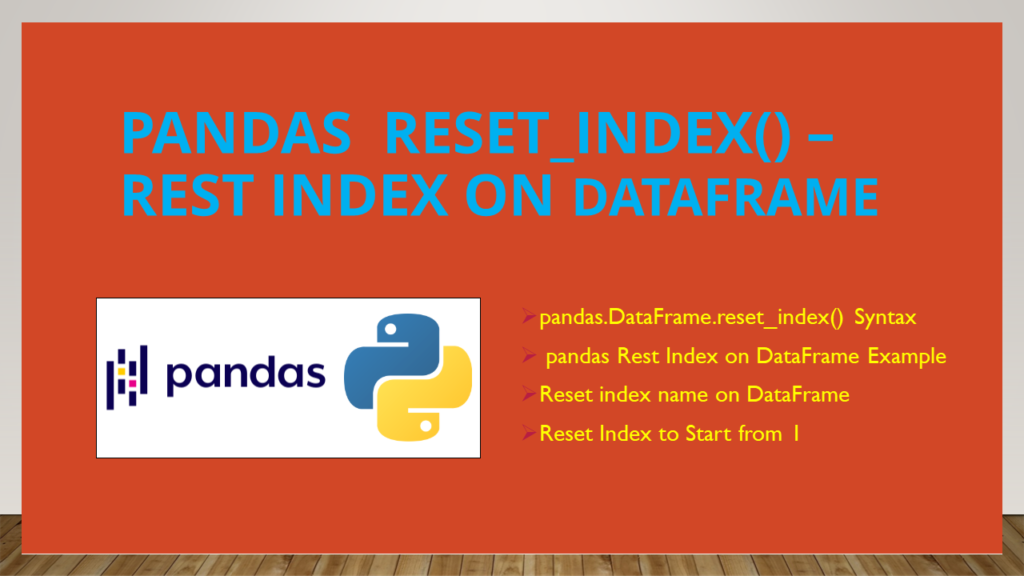DataFrame.reset_index() method is used to reset the index on the pandas DataFrame. This takes level, drop, inplace, col_level, col_fill as parameters and returns DataFrame. When inplace=True is used, it returns None. Use pandas.DataFrame.set_index() to set column as index.
In this article, I will cover how to reset index on pandas DataFrame with several examples. We are usually required to reset the index post dropping some rows from DataFrame as it creates a gap in the index.
1. Quick Examples of pandas reset index
Below are some quick examples of reset index on DataFrame.
# Quick examples of reset index
# Reset index
df2=df.reset_index()
# Reset index with out assigning to column
df.reset_index(inplace=True, drop=True)
# Set index column name
df.index.name = 'custom_index'
# Reset index starting from 1
df.index = np.arange(1, len(df) + 1)
2. pandas.DataFrame.reset_index() Syntax
Following is the syntax of the pandas.DataFrame.reset_index().
DataFrame.reset_index(level=None, drop=False, inplace=False, col_level=0, col_fill='')
level– Takes int, str, tuple, or list, default Nonedrop– bool, default False. When set to True, ignores setting old index as column.inplace– bool, default False. When set to True, it updates the existing DataFrame object.col_level– If the columns have multiple levels, determines which level the labels are inserted into.col_fill– If the columns have multiple levels, determines how the other levels are named.
Let’s create a pandas DataFrame with examples
import pandas as pd
# Create DataFrame from dict
df = pd.DataFrame({'Courses':['Spark','PySpark','Java','PHP'],
'Fee':[20000,20000,15000,10000],
'Duration':['35days','35days','40days','30days']})
df=df.drop([2])
print(df)
Yields below output
# Output:
Courses Fee Duration
0 Spark 20000 35days
1 PySpark 20000 35days
3 PHP 10000 30days
3. pandas Rest Index on DataFrame Example
Let’s use the pandas.DataFrame.reset_index() syntax to reset the DataFrame index. When we reset the index, the old index is added as a column to DataFrame, and a new sequential index is used
# Reset index on DataFrame
df2=df.reset_index()
print(df2)
Yields below output.
# Output:
index Courses Fee Duration
0 0 Spark 20000 35days
1 1 PySpark 20000 35days
2 3 PHP 10000 30days
If you don’t want to add the existing index as a column, use drop=True param and also use inplace=True to update the existing DataFrame.
# Drop index as column
df.reset_index(inplace=True, drop=True)
print(df)
Yields below output
# Output:
Courses Fee Duration
0 Spark 20000 35days
1 PySpark 20000 35days
2 PHP 10000 30days
4. Reset index name on DataFrame
Now, let’s see how to reset an index name on pandas DataFrame. By default, DataFrame creates with index name as ‘index’
# Set index name
df.index.name = 'custom_index'
print(df)
Yields below output.
# Output:
Courses Fee Duration
custom_index
0 Spark 20000 35days
1 PySpark 20000 35days
2 PHP 10000 30days
5. Reset Index to Start from 1
When you reset the index it assigns a numerical value starting from zero, some times you may need to assign from 1, you can do this as shown in the below example.
# Reset index starting from 1
df.index = np.arange(1, len(df) + 1)
print(df)
Yields below output
# Output:
Courses Fee Duration
1 Spark 20000 35days
2 PySpark 20000 35days
3 PHP 10000 30days
6. Complete Example of Reset Index on DataFrame
import pandas as pd
import numpy as np
# Create DataFrame from dict
df = pd.DataFrame({'Courses':['Spark','PySpark','Java','PHP'],
'Fee':[20000,20000,15000,10000],
'Duration':['35days','35days','40days','30days']})
df=df.drop([2])
print(df)
# Reset index
df2=df.reset_index()
print(df2)
# Reset index with out assigning to column
df.reset_index(inplace=True, drop=True)
print(df)
# Set index column name
df.index.name = 'custom_index'
print(df)
# Reset index starting from 1
df.index = np.arange(1, len(df) + 1)
print(df)
Conclusion
In this article, you have learned how to reset the index on DataFrame by using different prams on the reset_index() method.
Related Articles
- Pandas Drop Rows with NaN Values in DataFrame
- Pandas Drop Index Column Explained
- pandas.DataFrame.sort_values() – Examples
- pandas DataFrame.sort_index() – Sort by Index
- Pandas set_index() – Set Index to DataFrame
- Pandas melt() DataFrame Example
- How to Transpose() DataFrame in Pandas?
- Series.reindex() – Change the Index Order in Pandas Series
